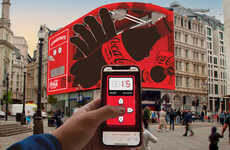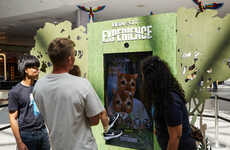
NHS Blood and Transplant's Donation Ad Interactively Builds Awareness
Laura McQuarrie — May 19, 2016 — Marketing
References: nhsbt.nhs.uk & eventmagazine
In order to encourage people in the UK to give blood, NHS Blood and Transplant set up a dynamic augmented reality donation ad. The awareness-raising advertisement takes the form of an interactive billboard that allows people to virtually "donate" blood just by using a smartphone.
When the companion AR app is opened, members of the public are able to stick a virtual needle and patch onto their arm, as if to draw blood. The simulation completes the "donation" by filling up a blood bag graphic on-screen that is pictured beside a patient in need.
While this experience may not be for the squeamish, it is an effective way for NHS Blood and Transplant to reach potential donors—approximately 200,000 new donors are needed every year.
When the companion AR app is opened, members of the public are able to stick a virtual needle and patch onto their arm, as if to draw blood. The simulation completes the "donation" by filling up a blood bag graphic on-screen that is pictured beside a patient in need.
While this experience may not be for the squeamish, it is an effective way for NHS Blood and Transplant to reach potential donors—approximately 200,000 new donors are needed every year.
Trend Themes
1. Interactive AR Advertisements - Augmented reality advertisements create an immersive and engaging experience for potential customers, leading to increased brand awareness and customer acquisition.
2. Virtual Healthcare Experiences - Virtual healthcare experiences make it easier and more convenient for patients to access healthcare services, and help medical professionals reach and treat more patients.
3. Gamification of Donations - Incentivizing donations through gamification can increase donor engagement and drive donations to important causes.
Industry Implications
1. Marketing and Advertising - The use of AR and other interactive technologies in advertising can revolutionize the way that companies create marketing campaigns and promote their products.
2. Healthcare - Virtual healthcare experiences can help improve access to healthcare services and reduce costs for providers and patients.
3. Nonprofits and Charity Organizations - Using gamification and other creative approaches can help nonprofit and charity organizations raise awareness and increase donations for important causes.
5.4
Score
Popularity
Activity
Freshness























